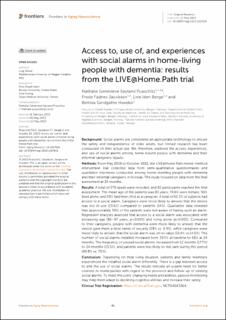| dc.contributor.author | Puaschitz, Nathalie Genevieve | |
| dc.contributor.author | Jacobsen, Frode F. | |
| dc.contributor.author | Berge, Line Iden | |
| dc.contributor.author | Husebo, Bettina S. | |
| dc.date.accessioned | 2023-06-09T09:15:00Z | |
| dc.date.available | 2023-06-09T09:15:00Z | |
| dc.date.created | 2023-05-24T16:59:18Z | |
| dc.date.issued | 2023 | |
| dc.identifier.citation | Frontiers in Aging Neuroscience. 2023, 15, | en_US |
| dc.identifier.issn | 1663-4365 | |
| dc.identifier.uri | https://hdl.handle.net/11250/3070706 | |
| dc.description | This is an open-access article
distributed under the terms of the Creative
Commons Attribution License (CC BY). The
use, distribution or reproduction in other
forums is permitted, provided the original
author(s) and the copyright owner(s) are
credited and that the original publication in this
journal is cited, in accordance with accepted
academic practice. No use, distribution or
reproduction is permitted which does not
comply with these terms. | en_US |
| dc.description.abstract | Background: Social alarms are considered an appropriate technology to ensure the safety and independence of older adults, but limited research has been conducted on their actual use. We, therefore, explored the access, experiences, and use of social alarms among home-bound people with dementia and their informal caregivers (dyads).
Methods: From May 2019 to October 2021, the LIVE@Home.Path mixed-method intervention trial collected data from semi-quantitative questionnaires and qualitative interviews conducted among home-dwelling people with dementia and their informal caregivers in Norway. The study focused on data from the final assessment at 24 months.
Results: A total of 278 dyads were included, and 82 participants reached the final assessment. The mean age of the patients was 83 years; 74.6% were female; 50% lived alone; and 58% had their child as a caregiver. A total of 62.2% of subjects had access to a social alarm. Caregivers were more likely to answer that the device was not in use (23.6%) compared to patients (14%). Qualitative data revealed that approximately 50% of the patients were not aware of having such an alarm. Regression analyses assessed that access to a social alarm was associated with increasing age (86–97 years, p = 0.005) and living alone (p < 0.001). Compared to their caregivers, people with dementia were more likely to answer that the device gave them a false sense of security (28% vs. 9.9%), while caregivers were more likely to answer that the social alarm was of no value (31.4% vs.14.0%). The number of social alarms installed increased from 39.5% at baseline to 68% at 24 months. The frequency of unused social alarms increased from 12 months (17.7%) to 24 months (23.5%), and patients were less likely to feel safe during this period (60.8% vs. 70%).
Conclusion: Depending on their living situation, patients and family members experienced the installed social alarm differently. There is a gap between access to and the use of social alarms. The results indicate an urgent need for better routines in municipalities with regard to the provision and follow-up of existing social alarms. To meet the users’ changing needs and abilities, passive monitoring may help them adapt to declining cognitive abilities and increase their safety. | en_US |
| dc.description.sponsorship | Conclusion: Depending on their living situation, patients and family members experienced the installed social alarm differently. There is a gap between access to and the use of social alarms. The results indicate an urgent need for better routines in municipalities with regard to the provision and follow-up of existing social alarms. To meet the users’ changing needs and abilities, passive monitoring may help them adapt to declining cognitive abilities and increase their safety. | en_US |
| dc.language.iso | eng | en_US |
| dc.publisher | Frontiers Media S.A. | en_US |
| dc.rights | Navngivelse 4.0 Internasjonal | * |
| dc.rights.uri | http://creativecommons.org/licenses/by/4.0/deed.no | * |
| dc.subject | experiences | en_US |
| dc.subject | use | en_US |
| dc.subject | access | en_US |
| dc.subject | indoor alarm | en_US |
| dc.subject | social alarm | en_US |
| dc.subject | telecare devices | en_US |
| dc.subject | assistive technology | en_US |
| dc.subject | dementia | en_US |
| dc.title | Access to, use of, and experiences with social alarms in home-living people with dementia: results from the LIVE@Home.Path trial | en_US |
| dc.type | Peer reviewed | en_US |
| dc.type | Journal article | en_US |
| dc.description.version | publishedVersion | en_US |
| dc.rights.holder | © 2023 Puaschitz, Jacobsen, Berge and Husebo. | en_US |
| dc.source.pagenumber | 1-11 | en_US |
| dc.source.volume | 15 | en_US |
| dc.source.journal | Frontiers in Aging Neuroscience | en_US |
| dc.identifier.doi | 10.3389/fnagi.2023.1167616 | |
| dc.identifier.cristin | 2149079 | |
| cristin.ispublished | true | |
| cristin.fulltext | original | |
| cristin.qualitycode | 1 | |

